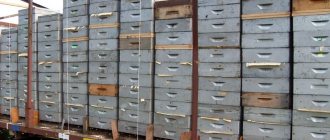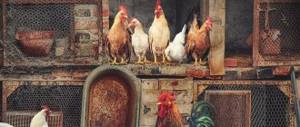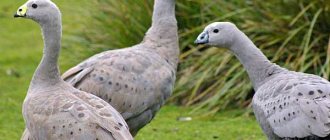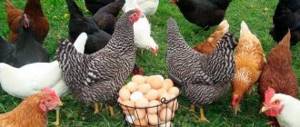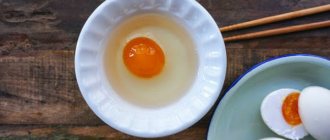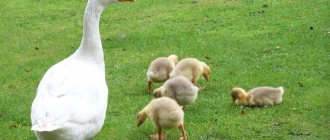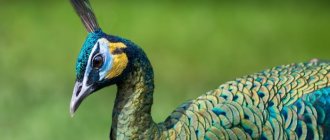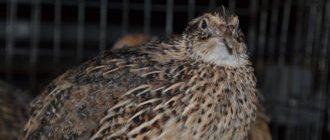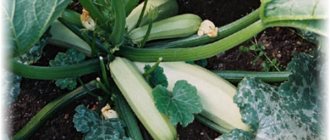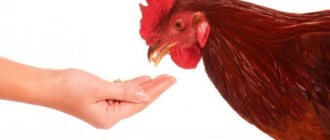- Wild animals
- >>
- Birds
The Ogar is a bright and distinctive red waterfowl that breeds in south-eastern Europe and Central Asia, migrating to South Asia for the winter.
Its bright rufous plumage contrasts with its pale cream head and neck. In captivity they are kept for ornamental purposes due to their bright plumage. They are usually aggressive and uncommunicative; it is better to keep them in pairs or disperse them over long distances. If you keep the Scorchfish together with ducks of other breeds, then in this case they become very aggressive during the nesting period.
Origin of the species and description
Photo: Ogar
The Shelduck (Tadorna ferruginea), along with the shelduck, is a member of the genus Tadorna, in the family Anatidae (anatidae). The bird was first described in 1764 by German zoologist/botanist Peter Pallas, who named it Anas ferruginea, but it was later transferred to the genus Tadorna. In some countries it is placed in the genus Casarca along with the South African grey-headed shelduck (T. cana), Australian shelduck (T. tadornoides) and New Zealand shelduck (T. variegata).
Interesting fact: Phylogenetic DNA analysis shows that the species is most closely related to the South African schard.
The genus name Tadorna comes from the French "tadorne" and possibly originally from the Celtic dialect meaning "motley waterfowl". The English name "sheld duck" dates back to around 1700 and means the same thing.
The species name ferruginea is Latin for "red" and refers to the color of the plumage. One of the Kazakh fairy tales says that rarely, once every few hundred years, a Tazy puppy hatches from an egg. Anyone who finds such a puppy will have good luck in all his affairs.
Appearance and features
Photo: Duck roast
Ogar - has become a fairly recognizable duck due to its special bright red color. All the closest relatives living in the southern hemisphere and having red patches in their plumage differ in the color of their heads. The Ogar grows to a length of 58 – 70 cm and has a wingspan of 115–135 cm, and its weight is 1000–1650 g.
The male has orange-brown body plumage and a paler, orange-brown head and neck, which is separated from the body by a narrow black collar. The flight feathers and tail feathers are black, and the inner surfaces of the wings have iridescent green shiny feathers. The upper and lower wings have a white underwing, this feature is especially noticeable during flight, but is barely visible when the bird is just sitting. The beak is black, the legs are dark gray.
Video: Ogar
The female is similar to the male, but has a rather pale, whitish head and neck and lacks a black collar, and in both sexes the coloring is variable and fades as the feathers age. Birds moult at the end of the breeding season. The male loses his black collar, but further partial molting between December and April restores it. The chicks look similar to the female, but are a darker shade of brown.
The Ogar swims well, and in flight it looks heavy, like a goose. A dark ring on the neck appears on the male during the nesting period, and females often have a white spot on the head. Bird call - consists of a series of loud, nasal honks, similar to a goose. Sound signals are given both on the ground and in the air, and vary depending on the circumstances under which they are made.
Raising ducklings for meat
The first period of oviposition in females lasts up to six months. During this time, they can lay up to 150 eggs, which means approximately 100 ducklings. Safety during cultivation is very high. Another no less popular breed of duck among poultry farmers is Ukrainian. There are three varieties: gray, clay and white. Gray ducks are more common, they are highly active both on land and in water, and are unpretentious to food and living conditions.
In homestead farming, it is most profitable to raise ducklings for meat
. They are bred under brood hens or one-day old ducklings are purchased at hatchery and poultry stations. What is important is that they are unpretentious and more viable than chickens and turkey poults. The room for ducklings is prepared in the same way as for chickens.
Purchased hatchery ducklings
need to be fed as early as possible. It is believed that then the residual yolk is absorbed more quickly and they develop faster and better. If during the first hours of raising the ducklings do not approach the feeder, then you should lightly tap on it, this will stimulate their pecking instinct. Ducklings that stubbornly refuse to feed should be force-fed using a pipette with a mixture of chicken yolk and milk, and also given a drink by carefully dipping their beaks into water. At the next feeding, the chicks usually begin to eat on their own.
Until 10 days of age, ducklings are fed 6-8 times a day, from 11 to 30 days of age - 4-5 times, and from 21 to 60 days of age - 4 times. In the first three days, hard-boiled, shelled eggs are good food for ducklings. They are finely chopped and mixed with crushed grain of corn, barley or oats without films. From the second or third day, fresh cottage cheese is included in the diet. Ducklings are usually fed wet mash consisting of grain flour, protein feed, chopped greens, soft aquatic vegetation, kitchen and table waste, garden waste. Wet mash should be crumbly. It is better to cook them with broths or dairy products (skim milk, buttermilk). Chopped fresh herbs can be added to young animals starting from the 4-5th day, and from the 10th day - boiled potatoes and chopped root vegetables. Ducklings are good at eating soft aquatic vegetation in crushed form - duckweed, elodea, etc. When ducklings are released onto a pond from 16-21 days of age, they are fed 3 times a day.
From the 30th day they switch to 2 times feeding. Moreover, the first feeding is carried out at 10-11 o’clock in the morning, and until this time the ducklings are on the pond. Ducklings should be released into the pond in the very early morning hours. Then at night the bird is driven indoors and fed ad libitum. The source of vitamins for ducklings is the greens of garden weeds, vegetable tops, vegetables and fruits unsuitable for human food. Ducklings are fed greens systematically, because if this is done irregularly, the bird begins to eat it too greedily, which can lead to blockage of the digestive tract and cause mass death of the young.
There should be constant water in the drinking bowls, as the ducklings moisten the swallowed food and rinse their nasal openings. Drinkers can be stationary in the form of a trough or vacuum, but always covered with a grate, since ducklings spray water and the bedding quickly gets wet. It is better to have a flow-through drinker covered with a grate on top. Starting from the fifth day of life, in the warm season, ducklings are released for walking. It should be fenced with mesh or other available material.
Ducklings are kept
in cages or on the floor with a stocking density of 20-25 heads per 1 m2 of floor; after 20 days of age, the stocking density is reduced to 10-13 heads. Ducklings grow quickly and reach a weight of 1.8-2.2 kg by the age of two months. The room temperature is maintained at 30 °C for the first week, then gradually reduced to 16-18 °C. The best assessment of room heating is the behavior of the ducklings themselves. If they are scattered over the entire floor area and are constantly in motion, the temperature regime is normal. If they crowd together near a heat source, climb on top of each other, and squeak pitifully, it means the temperature is too low for them. At high temperatures, ducklings breathe heavily with their open beaks, refuse food, and drink a lot often.
An important condition for the full-fledged raising of ducklings
is also the light mode. In the first week of life, ducklings are kept in 24-hour lighting; from the second week, daylight hours are reduced to 16-18 hours a day, and from the third week to 10 hours. Daylight hours are reduced to 8-9 hours by 20 days of age and this regime is left until five months of age, after which it is increased so that by 10 months of age the daylight hours are 15-16 hours.
The last batch of day-old ducklings is purchased in mid-September
, and by mid-November the poultry can be slaughtered. Since ducks have some biological characteristics, this must be taken into account when raising them. First of all, this is age-related molting, during which a complete change of plumage occurs. It begins at 55-60 days of age and lasts about two months. During molting, ducklings sharply lose weight, lose accumulated live weight, and carcasses lose their presentation. Therefore, ducks raised for meat must be slaughtered at the age of 50-60 days, before molting. In this case, feed costs are minimal and amount to 3-5 kg per 1 kg of growth, and for ducks older than 60 days, 8 times more is consumed.
You can successfully breed ducklings under a brooding duck.
. To do this, install nests from boxes (one nest for 5-7 ducks) at a height of 10-20 cm from the floor. You can equip nests along the walls of the poultry house, making them from boards, in the form of cells without a bottom, 40 cm wide, 50 cm deep and 25-30 cm high. The temperature in the room is maintained at 14-16 ° C. The best brood hen for ducklings, of course, is a duck, but they can also be bred under a chicken. In this case, it is not advisable to release the ducklings into the pond, as this will worry the hen.
collected from nests and intended for incubation
or incubation, immediately placed in a cool place (12-16 ° C with a humidity of 70-80%) and stored horizontally for no more than a week, turning them 180 ° daily. Contaminated eggs are usually not used for incubation; washing and wiping eggs is not recommended, as the protective film on the shell is erased. After collection and before incubation (brooding), eggs should be disinfected with formalin mixed with potassium permanganate (15 ml of formalin + 15 ml of water + 10 g of potassium permanganate). During the incubation process, the eggs are examined with an ovoscope once a week, removing unfertilized, frozen, blood-ringed eggs and especially “cuffs” (spoiled eggs) from the nests. A week before hatching, you need to ensure that the brood ducks leave the nest for about half an hour two or three times a day, during which time the eggs should cool.
Where does the firebug live?
Photo: Ogar bird
Populations of this species are very small in northwestern Africa and Ethiopia. The main habitat of the ogre extends from southeastern Europe through Central Asia to Lake Baikal, Mongolia and western China. The eastern populations mainly migrate and winter in the Indian subcontinent.
The species colonized the island of Fuerteventura in the Canary Islands, first breeding there in 1994 and reaching almost fifty pairs by 2008. In Moscow, individuals of the Scorch released in 1958 created a population that numbered 1,100. Unlike other representatives of this species in Russia, these red ducks do not migrate to the south, but return during the winter to the territory of the zoo, where all conditions have been created for them.
The main habitats are in:
- Greece;
- Bulgaria;
- Romania;
- Russia;
- Iraq;
- Iran;
- Afghanistan;
- Turkey;
- Kazakhstan;
- China;
- Mongolia;
- Tyva.
The ogary is a common winter visitor to India, arriving in October and leaving in April. The typical habitat of this duck is large wetlands and rivers with mud flats and pebbly banks. Ogar is found in large numbers on lakes and reservoirs. Breeds in high mountain lakes and swamps in Jammu and Kashmir.
Outside the breeding season, the duck prefers lowland streams, slow rivers, ponds, meadows, swamps and brackish lagoons. It is rarely found in forested areas. Although the species is more common in the lowlands, it can live at higher altitudes, in lakes at an altitude of 5000 m.
Even though the squid is becoming quite rare in southeastern Europe and southern Spain, the bird is still widespread throughout much of its Asian range. Perhaps it is these populations that give rise to vagrant individuals that fly as far west as Iceland, Great Britain and Ireland. The wild fire is successfully bred in several European countries. In Switzerland it is considered an invasive species that threatens to displace native birds. Despite actions taken to reduce numbers, the Swiss population increased from 211 to 1,250.
Now you know where the cinder lives, let's see what a duck eats in its natural environment.
The first pair of fires appeared in the “Apothecary Garden”
The first pair of ogary (red ducks) appeared in the Botanical Garden of Moscow State University “Apothecary Garden” - they were noticed by the garden’s landscape architect Artem Parshin near one of the collection’s greenhouses with orchids and personally conducted a photo shoot. Now they are floating in a long ditch near the concert and exhibition field.
The same couple has been flying to the “Apothecary Garden” for many years in a row. In 2021, this happened on March 2. Ogars occupy the second place in number among birds wintering in Moscow. The capital's firecrackers are descendants of birds that once lived on the zoo's pond: in the 1950s, their wings were no longer clipped, and red ducks began to spread throughout the ponds of the metropolis. In January 2021, ornithologists counted a record number of scorches in Moscow - more than 1,430 individuals.
Director of the “Pharmaceutical Garden” Alexey Reteyum:
— Every year, the appearance of fires in the garden in early March is a sign of the onset of real spring! In the first days, they usually stay either in the ditch near the Seedling Greenhouse, where the “Spring Rehearsal” exhibition is taking place, or by the square pool, where red-eared turtles will return after wintering in mid-April. Red ducks arouse interest and affection among every guest of the garden - they are photographed and filmed throughout the day.
And, of course, they try to feed! However, feeding the animals of the “Apothecary Garden” is strictly prohibited according to the rules of the garden - employees take great care of the well-being of their pets, and bread, rolls, cookies and other standard treats can kill them. We fight against this every year and appeal to the consciousness of visitors. Imagine, a few years ago they tried to feed our Japanese carp with yogurt!..
Squirrels nest on the roofs of tall buildings not far from the garden - in Grokholsky and Protopopovsky lanes, on Mira Avenue. Local residents often see them and tell us about it on social networks. At the end of May, having barely hatched, their chicks fearlessly jump from great heights and then follow their mother to the nearby pond of the “Apothecary Garden”. It happens that the police even block traffic for the passage of a duck brood. Unfortunately, every few years there are emergencies: ducks and ducklings are crushed by vehicles.
So, in 2013, a cinder nest was on the other side of Mira Avenue. Then the duck died under the wheels, and passers-by witnesses brought two surviving ducklings into the garden. Another couple with ducklings did not accept strangers, and they had to be given to a shelter near Moscow.
Unlike other ducks, the female chooses a partner for the pair. These birds are not native to our region. In Russia (in the wild) they live in the steppe zone of the Krasnodar Territory.
Usually, during the warm season, two or three families of sturgeons live in the “Apothecary Garden” at the same time, which delight both children and adults. Ogars feed on seeds and shoots of saltworts, grain, locusts, and in lakes they catch larvae, insects and small crayfish.
In summer, the chicks are hunted by crows and local cats, with the exception of the symbol of the garden - the Chief Flower Cat. Tragedies are inevitable. So, in 2015, at the end of June, literally overnight, twenty red ducklings and three pairs of red ducks disappeared from the garden. The very first brood of 4 kids came to the garden on May 24, but a day later they were all eaten by treacherous crows and, as it turned out, by a cat.
Until April 7 – Festival of orchids, carnivorous plants and desert plants “Tropical Winter”.
“Apothecary Garden” is open daily from 10.00 to 20.00.
What does the firefly eat?
Photo: Ogar in Moscow
Ogar feeds mainly on plant foods, sometimes animals, giving preference to the former. The proportions of food intake depend on the area where it is located and the time of year. Food intake is carried out on land and on water, preferably land, which significantly distinguishes the red duck from the closely related shelduck.
Favorite food products of plant origin include:
- herbs;
- leaves;
- seeds;
- stems of aquatic plants;
- corn;
- vegetable shoots.
In the spring, the cinder tries to forage on lawns and between dunes, looking for green shoots and seeds of grasses such as saltwort or cereals. During the breeding season, when offspring appear, birds can be seen on salt licks hunting for insects (mainly locusts). On lakes it feeds on invertebrates such as worms, crustaceans, aquatic insects, as well as frogs + tadpoles and small fish.
By the end of summer and autumn, the firebug begins to fly into fields sown with winter crops or already harvested, in search of seeds of grain crops - millet, wheat, etc. They happily eat grain scattered along the roads. They may visit garbage dumps. There are known situations when these ducks, like crows and other birds, even ate carrion. Ducks search for food more actively at dusk and at night, and rest during the daytime.
Diet and feeding behavior
Ogars feed both on water and on land. In the water, they either turn upside down, like red floats, or “chew the water” on the surface, straining out small crustaceans and other invertebrates with their beaks or nibbling aquatic plants. Scorches feed in shallow water: they swim well, but dive poorly, with difficulty submerging entirely, and the water immediately pushes them to the surface. On land, fires graze like geese. Plant food often predominates in the diet of scorches, but the ratio of plant and animal food depends on both the time of year and the region. In the spring, fires pluck out grass seedlings in meadows and fields; in dry steppes and deserts, saltwort sprouts become food. At the end of summer and autumn, fires pick up plant seeds from the ground and often visit winter crop fields. In the summer, when the grass becomes coarser and dries out, the fires turn to animal feed. They hunt for small animals (including insects, worms, aquatic crustaceans, mollusks and other invertebrates, tadpoles, small frogs and fish) both in water and on land. In the steppe, a large role is played by grasshoppers (a group of locusts), which the fires collect in the morning, before the insects have warmed up and are in a daze.
Features of character and lifestyle
Photo: Female Ogar duck
The gorse is found in pairs or small groups and rarely forms large flocks. However, aggregations during wintering or molting on selected lakes or slow-moving rivers can be very large. Red ducks are clumsy on the ground due to the special position of their legs on their bodies. Their paws are placed far back, making walking difficult. However, this morphology makes them exceptionally fast and agile in the water.
They can dive or submerge themselves in water without much effort. These ducks, propelled by a single movement of their legs, dive about a meter below the surface until they reach the substrate where they forage for food. During a dive, the legs paddle simultaneously while the wings remain closed. To get into the air, these ducks must beat their wings quickly and run across the surface of the water. The ogre flies at relatively low altitudes above water.
Interesting fact: The staghorn does not actively defend territory and does not limit itself to a specific home range during any part of the year. They rarely interact with other birds, and juveniles tend to be aggressive towards other species.
The maximum lifespan of red ducks in the wild is 13 years. However, according to the Global Invasive Species Database, these ducks, when trapped and tracked in the wild, rarely survive past 2 years. Birds kept in captivity have an average lifespan of 2.4 years.
Conditions of detention and care
An important characteristic of Moscow white ducks is their ability to quickly adapt to different weather conditions. Representatives of the breed grow quickly, are unpretentious in maintenance and have high immunity.
Caring for and feeding ducks does not require much physical effort and time. In winter, they can be kept in an insulated but not heated room.
A prerequisite for their maintenance is cleanliness. The bird should not be given sour food or drink dirty water. There should be no drafts in the duck room.
You can feed ducks not only with feed mixtures, but also with grain, boiled vegetables from the garden, beet and carrot tops. In autumn they are fed pumpkin, cabbage and potatoes. Good growth is observed in representatives of the breed when they are fed duckweed.
The poultry run should have a fence 1.8-2 meters high. It must be located from bodies of water. If there is none near the poultry house, then deep troughs are installed in the duck pen. It is very important to give calcium supplements to ducks along with their feed. You can start including them in your diet from the first weeks of their life.
Moscow white ducks have good immunity. They rarely get sick and have a very high survival rate when bred. The cause of their diseases is most often poor-quality feed and violation of poultry management rules.
The most dangerous
Infectious diseases pose an increased danger to ducks. They spread very quickly, affecting the entire herd. Among non-infectious diseases, the most common avian diseases encountered in poultry farming are vitamin deficiency, diarrhea and parasite infestation.
Preventive measures
Compliance with the rules of keeping and feeding poultry significantly reduces the risk of poultry diseases. Their feeding diet includes vitamins and microelements that increase the immunity of ducks. Poultry housing must be regularly disinfected. It is not allowed to keep sick and healthy ducks together.
Social structure and reproduction
Photo: Smoldering Duckling
The birds arrive at their main breeding grounds in Central Asia in March and April. There is a strong pair bond between the male and female and they are believed to mate for life. In their breeding grounds, the birds are very aggressive towards their own species and other species. The females, seeing the intruder, approach him with a bowed head and an outstretched neck, uttering angry sounds. If the intruder stands still, she returns to the male and runs around him, inciting him to attack.
Mating occurs on the water after a short mating ritual involving neck stretching, head touching and tail raising. Nesting sites are often far from water in a hole, in a tree, a destroyed building, in a rock crevice, among sand dunes or in an animal burrow. The nest is built by the female using feathers and down and some grasses.
A clutch of eight eggs (six to twelve) is laid between late April and early June. They have a dull luster and creamy white color, averaging 68 by 47 mm. Incubation is carried out by the female, and the male is nearby. The eggs hatch in about twenty-eight days, and both parents care for the young, which will fly away in another fifty-five days. Before molting, they move to larger bodies of water where they can more easily avoid predators while they are not flying.
Interesting Fact: Female Scorchfish invest heavily in their chicks. From hatching until 2-4 weeks of age, the female is very attentive to the brood. She stays close while feeding and also exhibits aggressive behavior when ducks of other ages approach. Females also reduce their diving time while the young brood dives with her to monitor and protect the chicks.
The family may stay together as a group for some time; autumn migration begins around September. North African birds breed about five weeks earlier.
Distribution and habitats
Ogar is widespread in the steppe and desert regions of Eurasia, from the Black Sea region and the Anatolian Peninsula in the west to the Amur region in the east. With the onset of cold weather, the fires living in the northern part of their range go for the winter to Southeast Asia, India or Africa (along the Nile). In other, warmer parts of their range, sardines lead a nomadic lifestyle, flying from areas of drought to preserved bodies of water. In the upper reaches of the Nile and in north-west Africa, fires live year-round; There are also permanent habitats of smoldering fires in the Middle East (in the south of Turkey, in the south of the Caspian Sea, between the Tigris and Euphrates rivers) and in Central Asia (between the Amu Darya and Syr Darya rivers). Ogars are also found in the mountains; in the Himalayas, red ducks have been observed above 5000 m. Ogars live in large rivers and lakes, including brackish and salty ones, but are less attached to water than other ducks, for example, their relatives shelducks. In the steppes, fires stick to low-grass areas, and avoid places with tall, dense grass and banks with dense thickets - in tall grass it is more difficult to move, and predators are not visible. Bodies of water are often used as refuges from land-based predators rather than as dining areas. For example, sardines populate lakes in the mountain steppes where other ducks do not stay: without coastal thickets where they can hide, with a pebble bottom and a small amount of animal food.
Natural enemies of fire
Photo: Duck roast
The firefish's ability to dive below the surface of the water allows them to avoid many predators. During the breeding season, they build nests using surrounding vegetation, which provides cover and camouflage for protection from predators that prey on eggs and ducklings. Females often try to distract predators from nests by leading them away. Their eggs are proportionally the largest of any waterfowl.
Eggs and chicks are hunted by predators such as:
- raccoons (Procyon);
- mink (Mustela lutreola);
- gray herons (Árdea cinérea);
- common night herons (Nycticorax nycticorax);
- seagulls (Larus).
Ogar spends most of his time on the water. They are fast fliers but have little maneuverability in the air, and so tend to swim and dive rather than fly to escape predators. They are very aggressive towards each other and other species, especially during the breeding season.
Known predators that prey on adults include:
- raccoons (Procyon);
- mink (Mustela lutreola);
- hawks (Accipitrinae);
- owls (Strigiformes);
- foxes (Vulpes Vulpes).
Humans (Homo Sapiens) also legally hunt red ducks throughout almost their entire distribution range. Although they have been hunted for many years, and numbers have likely declined over that time, they are not very popular among hunters today. Ogar are heavily dependent on wetlands, but grazing, burning and draining of wetlands have led to the deterioration of their habitat conditions.
Description of the breed
The Moscow white duck can be found in households in various regions of the country. The breed was bred in the middle of the last century by breeders from the Ptichnoye state farm in the Moscow region.
Work on its removal began before the Second World War and did not stop even in the most difficult time for the country. The breeders were faced with the task of creating a fast-maturing productive breed of ducks, adapted to the harsh weather conditions of the Russian regions.
Appearance
The Moscow white duck resembles in its appearance representatives of the Peking and Blagovarian breeds. Blagovarian ducks can be distinguished from Moscow ducks only by the color of their beaks. In birds of the Blagovarian breed it is bright orange. The tip of the beak is painted black. Muscovy ducks have pink or red beaks. The body of ducks is wide and slightly raised, the chest is rounded.
The bird's small head is set on a medium-thick flexible neck. They have wide-set short legs and blue eyes. Moscow white ducks are considered heavyweights. An adult drake reaches a weight of 4 kg, the female gains weight of 3.5 kg. You can distinguish a drake from a female by the curled feathers on the bird's tail.
Character and behavior
Moscow white ducks love to swim and dive. One of their characteristics is gluttony. They are very easy-going and do not cause much trouble to the owner.
If a hole is found in the fence, the ducks will definitely use it and leave the enclosure. Ducks that leave the pen very rarely come back.
